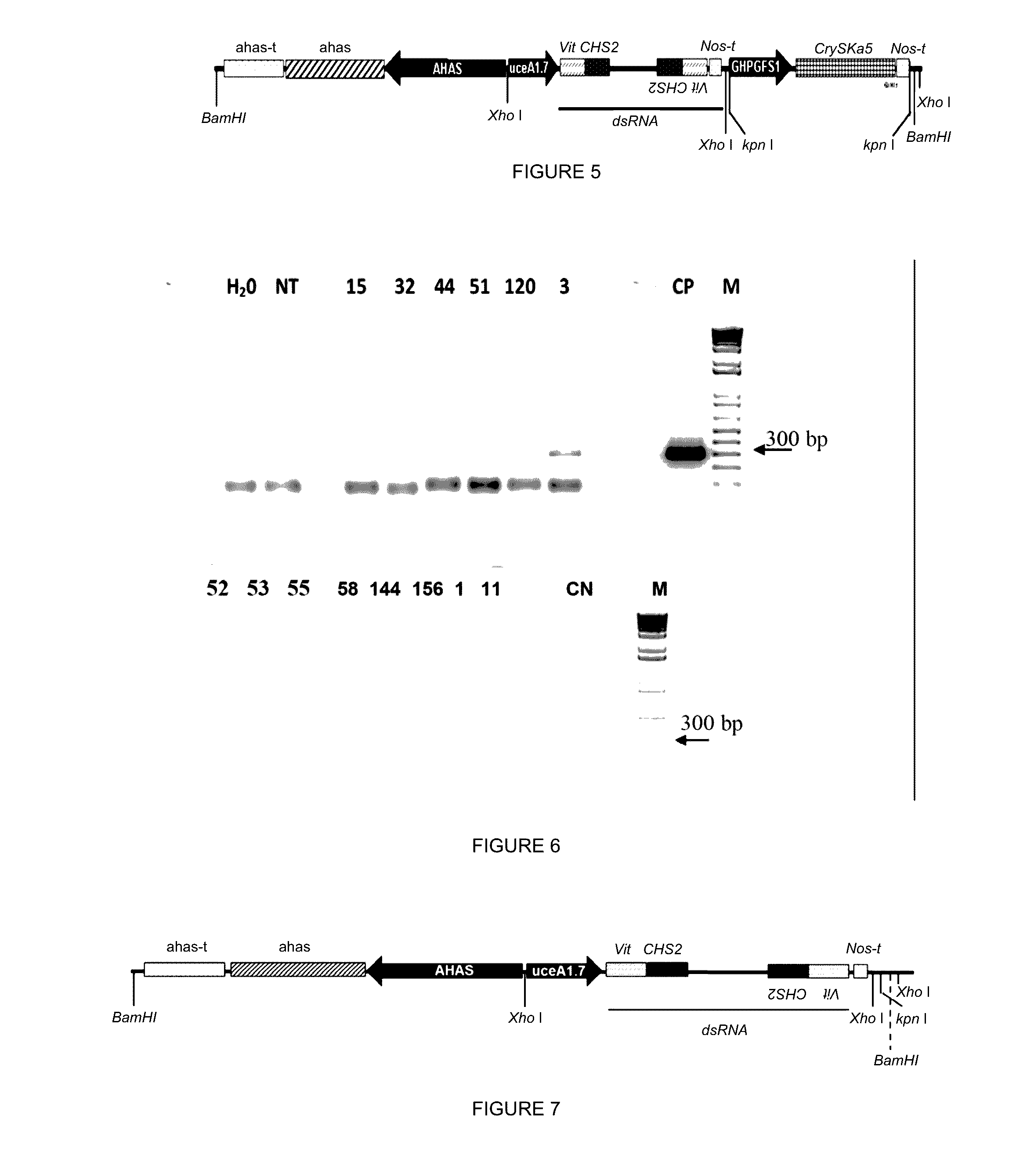Method and compositions for controlling insect pests on plants by silencing genes of the chitin synthase and vitellogenin family, and alternatively by expression of a cry toxin gene
a technology of insect pests and genes, applied in the field of controlling insects, can solve the problems of increasing production costs, destroying nature and health of field workers, and even killing organisms,
- Summary
- Abstract
- Description
- Claims
- Application Information
AI Technical Summary
Benefits of technology
Problems solved by technology
Method used
Image
Examples
example 1
Identification of Nucleotide Sequence of the Protein Vitellogenin of Anthonomus grandis for Preparing the dsRNA
[0118]Eggs, larvae and adult insects of A. grandis were obtained from the Laboratório de bioecologia e semioquímicos de insetos da Embrapa Recursos Genéticos e Biotecnologia em Brasília-DF (Laboratory of bioecology and semiochemicals of insects of the EMBRAPA Genetic Resources and Biotechnology in Brasilia-DF) R. The colony is fed with an artificial diet as described in by Oliveira et al (2011) and kept at 26±2° C., relative unit of 60±10% and 12-hour photoperiod. For cloning and sequencing vitellogenin of A. grandis, the total RNA was isolated from adult insects using Trizol (Invitrogen), following the protocol indicated by the maker The cDNA was synthesized from □□g of total RNA using the kit Superscript II™ First-Strand Synthesis System for RT-PCR (Invitrogen) using oligo oligo d(T)-AP. For initial amplification of the gene fragment of vitellogenin of A. grandis, one use...
example 2
Bioassays of Microinjection of dsRNA in Anthonomus grandis
[0120]Samples of double-stranded RNA (dsRNA) were carried out in bioassays against cotton-boll weevil. The dsRNA was prepared from sequences identified as described in example 1. For the microinjection bioassays, the dsRNA molecules in all the treatments were injected into the dorsal abdominal region of adult females with up to 24 hours' emergency 24. In order to carry out this procedure, it was necessary to raise one of the elytra so as to expose the microinjection site. After the injection, the females were kept under standard feeding conditions on artificial diet, and couples were formed to enable copulation.
[0121]In order to evaluate the effect of the dsRNA on the expression of the target transcript, one used the PCR technique in real time and the reference genes: GAPDH and beta-Actina. In the microinjection assays aiming at the effect of silencing the vitellogenin, one evaluated a few variables as described hereinafter:...
example 3
Results of the Bioassays of Microinjection of dsRNA and Evaluation of Gene Silencing for the Protein Vitellogenin on A. grandis
[0123]One identified the sequence fragment of cDNA of the gene of the Vitellogenin of A. grandis, the size of which was of 400 nucleotides (SEQ ID NO 2), which served as a mold for the synthesis of dsRNA molecules, as described in example 1. One verified, by means of the microinjection bioassays and by the results of the PCT analysis in real time that the dsRNA molecules were capable of reducing the number of transcripts of Vitellogenin (FIG. 1). Also by PCR analyses in real time, one observed that in adult insects, microinjections of de 500 ng of dsRNA were sufficient for causing, after 72 hours, a drastic reduction of the number of transcripts (FIG. 1).
[0124]In the evaluation of phenotypical parameters caused by microinjection of the dsRNA of Vitellogenin, one verified that the females were capable of carrying out oviposition in the same way as the female...
PUM
 Login to View More
Login to View More Abstract
Description
Claims
Application Information
 Login to View More
Login to View More - R&D
- Intellectual Property
- Life Sciences
- Materials
- Tech Scout
- Unparalleled Data Quality
- Higher Quality Content
- 60% Fewer Hallucinations
Browse by: Latest US Patents, China's latest patents, Technical Efficacy Thesaurus, Application Domain, Technology Topic, Popular Technical Reports.
© 2025 PatSnap. All rights reserved.Legal|Privacy policy|Modern Slavery Act Transparency Statement|Sitemap|About US| Contact US: help@patsnap.com



